2019-09-05 - Nº 227
Editorial
Esta é a Newsletter Nº 227 que se apresenta com o mesmo formato que as anteriores. Se gostar da Newsletter partilhe-a!
Todas as Newsletters encontram-se indexadas no link.
Esta Newsletter tem os seguintes tópicos:
Faz hoje anos que nascia, em 1667, Girolamo Saccheri. Este Matemático italiano trabalhou para provar o quinto postulado de Euclides, que pode ser declarado como: "Através de qualquer ponto que não esteja numa determinada linha, uma e apenas uma linha podem ser traçadas paralelas à linha". Euclides viu que a prova não era evidente, mas também não a forneceu; em vez disso, ele a aceitou como uma suposição. Posteriormente, muitos matemáticos tentaram provar este quinto postulado a partir dos restantes axiomas - e falharam. Saccheri adoptou a nova abordagem de assumir primeiro que o postulado estava errado, depois seguiu todas as consequências, procurando qualquer contradição que deixasse o único postulado original como a única solução possível. No processo, ele chegou perto de descobrir a geometria não euclidiana, mas desistiu cedo demais.
Faz também anos hoje que nascia, em 1850, Eugen Goldstein. Este físico alemão descobriu e nomeou os raios do canal (1886) que emergem através de orifícios nos ânodos dos tubos de descarga eléctrica de baixa pressão (posteriormente mostrados como partículas carregadas positivamente). Anteriormente, ele designou o termo "raio catódico" (1876) emitido a partir de um cátodo. Ele foi o primeiro a ver que eles podiam projectar uma sombra e foram emitidos perpendicularmente à superfície. Ele também investigou os comprimentos de onda da luz emitida por metais e óxidos quando os raios do canal colidem sobre eles.
Por fim, faz anos hoje que nascia, em 1932, Robert H. Dennard. Este Engenheiro electrotécnico norte-americano é responsável pela invenção da memória dinâmica de acesso aleatório (DRAM), para a qual foi emitida uma patente em 1968. Dennard também foi um dos primeiros a reconhecer o tremendo potencial de reduzir os MOSFETs. A teoria de escala que ele e seus colegas formularam em 1974 postulou que os MOSFETs continuam a funcionar como interruptores controlados por tensão, enquanto todas as figuras de mérito, como densidade de layout, velocidade operacional e eficiência energética, melhoram - desde que as dimensões geométricas, as tensões e concentrações de doping sejam consistentemente dimensionadas para manter o mesmo campo eléctrico. Esta propriedade está subjacente ao cumprimento da Lei de Moore e à evolução da micro-electrónica nas últimas décadas.
Nesta semana que passou a nave espacial Indiana Chandrayaan-2 libertou a sonda Vikram que irá aterrar na Lua. As duas metades da missão lunar da Índia se separaram em preparação para o momento mais importante de todo o esforço. A 2 de Setembro, a missão Chandrayaan-2 dividiu-se em duas naves espaciais distintas: uma que irá circular pelos pólos da Lua por cerca de um ano e um módulo de aterragem que, no final desta semana, tentará o primeiro toque da Índia na Lua.
Também esta semana ficámos a saber que foi lançada a especificação USB 4. Esta vem essencialmente permitir a operação de duas faixas usando cabos USB Type-C existentes e operação de até 40 Gbps em cabos certificados, os vários protocolos de dados e exibição irão partilhar com eficiência a largura de banda agregada máxima, e a compatibilidade com versões anteriores com USB 3.2, USB 2.0 e Thunderbolt 3.
Por fim, é esperado que um asteróide maior que a Torre Eiffel possa passar perto da Terra nas próximas horas. O GT3 2019 é classificado como um "asteróide potencialmente perigoso", o que significa que está a ser examinado detalhadamente pela comunidade astronómica, apenas algumas semanas após a passagem muito próxima de outro sobrevoo - o de um objecto "aniquilador de cidades" com a designação de 2019 OK. A NASA alertou que este asteróide gigantesco que ultrapassa uma bomba nuclear de 50 mega-toneladas de energia passará pela Terra amanhã. A rocha espacial em questão, que tem o nome de 2019 GT3, tem uns impressionantes 370 metros de largura, maior em tamanho do que a icónica Torre Eiffel.
Na Newsletter desta semana apresentamos diversos projetos de maker.
 João Alves ([email protected])
João Alves ([email protected])
O conteúdo da Newsletter encontra-se sob a licença  Creative Commons Attribution-NonCommercial-ShareAlike 4.0 International License.
Creative Commons Attribution-NonCommercial-ShareAlike 4.0 International License.
Novidades da Semana
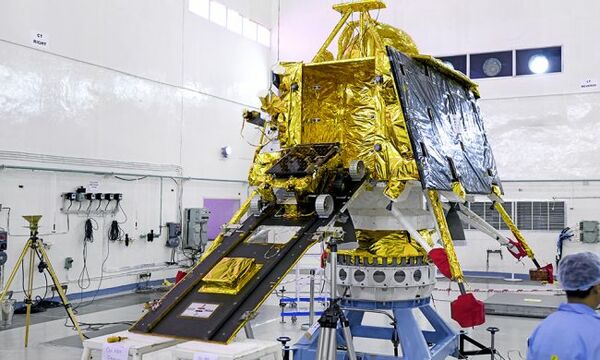
India's Chandrayaan-2 Moon Orbiter Releases Vikram Lunar Lander
"The two halves of India's moon mission have parted ways in preparation for the tensest moment of the entire endeavor. Today (Sept. 2), the Chandrayaan-2 mission split into two separate spacecraft: an orbiter that will circle the moon's poles for about a year and a lander that will, later this week, attempt India's first touchdown on the moon. "All the systems of Chandrayaan-2 Orbiter and Lander are healthy," Indian Space Research Organisation (ISRO) officials said in a statement. The separation occurred around 3:45 a.m. EDT (745 GMT). So far, both spacecraft are faring well in their separate orbits, ISRO officials added. The Chandrayaan-2 mission launched in July, taking the slow road to the moon, where it arrived in orbit on Aug. 20." [...]

USB-IF Announces Publication of USB4™ Specification
"Specification now available for download on USB-IF website; doubles bandwidth to extend USB Type-C® performance USB Implementers Forum (USB-IF), the support organization for the advancement and adoption of USB technology, today announced the publication of the USB4™ specification, a major update to deliver the next-generation USB architecture that complements and builds upon the existing USB 3.2 and USB 2.0 architectures. The USB4 architecture is based on the Thunderbolt™ protocol specification recently contributed by Intel Corporation to the USB Promoter Group. It doubles the maximum aggregate bandwidth of USB and enables multiple simultaneous data and display protocols. The development of the USB4 specification was first announced in March 2019 by the USB Promoter Group. It is now officially published by USB-IF and available for download at www.usb.org. Key characteristics of the USB4 solution include: • Two-lane operation using existing USB Type-C® cables and up to 40Gbps operation over 40Gbps certified cables • Multiple data and display protocols that efficiently share the maximum aggregate bandwidth • Backward compatibility with USB 3.2, USB 2.0 and Thunderbolt 3 As the USB Type-C connector has evolved into the role as the external display port of many host products, the USB4 specification provides the host the ability to optimally scale allocations for display data flow." [...]

Asteroid Greater in Size Than Eiffel Tower May Race Past Earth in Hours to Come
"The 2019 GT3 is classified as a “potentially hazardous asteroid”, which means it is being scrutinised in detail by the astronomic community, just weeks after the near miss of another flyby – that of a “city-killer” object with the way too positive codename of 2019 OK. NASA has warned that a mammoth asteroid surpassing a 50 megaton nuke in power will whizz past Earth tomorrow. The space rock in question, which goes by the name 2019 GT3, is a whopping 1,214 feet wide, which is greater in size than the iconic Eiffel Tower. Given the massive size, the object that is moving at a breakneck speed of 30,500 mph is feared to have the potential to produce a gigantic crater in the event of a collision with Earth – about three miles wide. At its closest point to our planet’s surface, the asteroid will be within a distance equalling 0.04996 astronomical units or around 4.6 million miles, which lands it into the category of “potentially hazardous asteroids”, commonly referred to by the abbreviation PHA. NASA has classified the location where the object is heading to as the "near-Earth object" zone, or the “main belt” that is believed to attract asteroids like a magnet, especially given the fact that cosmic rocks are drawn to Earth by gravitational forces. According to a report by spacetelescope.org, there are over 700,000 rocks in space." [...]
Outras Notícias

IBM Gives Away PowerPC; Goes Open Source - Want to Design Your Own 64-bit RISC Processor on the Cheap?
"Remember PowerPC? Nah, me neither. But now it can be yours. For free. Srsly. IBM has released the Power Architecture instruction set to the Linux Foundation, making it freely available to anyone who wants it." [...]

Hyundai Develops Wearable Vest Exoskeleton for overhead work
"Hyundai Motor Group has developed the new Vest EXoskeleton (VEX), a wearable robot created to assist industrial workers who spend long hours working in overhead environments. The VEX enhances productivity and reduces fatigue of industrial workers by imitating the movement of human joints to boost load support and mobility. The wearable vest features a polycentric axis – combining multiple pivot points with multi-link muscular assistance – to function, eliminating the need for a battery. At 2.5kg, VEX weighs 22-42% less than competing products and is worn like a backpack. The user places their arms through the shoulder straps of the vest, then fastens the chest and waist buckles. The back section can adjust in length by up to 18 cm to fit a variety of body sizes, while the degree of force assistance can be adjusted over six levels – up to as much as 5.5 kgf." [...]
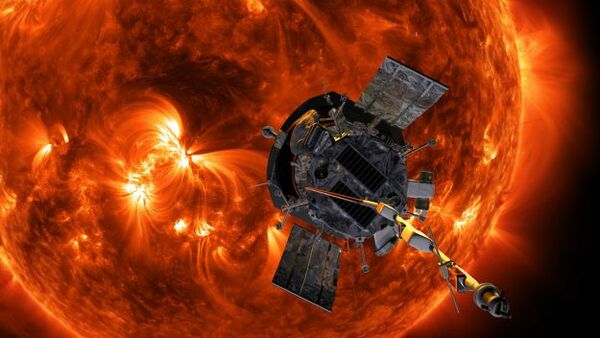
Parker Solar Probe Completes Third Close Approach of the Sun
"At just before 1:50 p.m. EDT on Sept. 1, 2019, NASA’s Parker Solar Probe completed its third close approach of the Sun, called perihelion. At the time of perihelion, the spacecraft was about 15 million miles from the Sun’s surface, traveling at more than 213,200 miles per hour. Mission controllers at the Johns Hopkins Applied Physics Laboratory in Laurel, Maryland, received a green “A” beacon from the spacecraft soon after perihelion, meaning all systems were performing as designed and that the spacecraft was in good health. This third encounter, which was at approximately the same distance from the Sun and speed as the first two, differs in that the spacecraft’s four instrument suites have been on and gathering data for a longer period than other perihelia. For this third solar encounter, the mission team turned on the instruments when the spacecraft was around 0.45 astronomical units from the Sun on the inbound side of its orbit. (One astronomical unit, or AU, is about 93 million miles, the average distance between the Sun and Earth.)" [...]

China's Lunar Rover Has Found Something Weird on the Far Side of the Moon
"China's Chang'e-4 lunar rover has discovered an unusually colored, 'gel-like' substance during its exploration activities on the far side of the moon. The mission's rover, Yutu-2, stumbled on that surprise during lunar day 8. The discovery prompted scientists on the mission to postpone other driving plans for the rover, and instead focus its instruments on trying to figure out what the strange material is. Day 8 started on July 25; Yutu-2 began navigating a path through an area littered with various small impact craters, with the help and planning of drivers at the Beijing Aerospace Control Center, according to a Yutu-2 'drive diary' published on Aug. 17 by the government-sanctioned Chinese-language publication Our Space, which focuses on space and science communication. On July 28, the Chang'e-4 team was preparing to power Yutu-2 down for its usual midday 'nap' to protect the rover from high temperatures and radiation from the sun high in the sky. A team member checking images from the rover's main camera spotted a small crater that seemed to contain material with a color and luster unlike that of the surrounding lunar surface." [...]
Ciência e Tecnologia

Ultrathin 3-D-printed films convert energy of one form into another
"Low-cost “piezoelectric” films produce voltage, could be used for flexible electronic components and more. MIT researchers have developed a simple, low-cost method to 3-D print ultrathin films with high-performing “piezoelectric” properties, which could be used for components in flexible electronics or highly sensitive biosensors. Piezoelectric materials produce a voltage in response to physical strain, and they respond to a voltage by physically deforming. They’re commonly used for transducers, which convert energy of one form into another. Robotic actuators, for instance, use piezoelectric materials to move joints and parts in response to an electrical signal. And various sensors use the materials to convert changes in pressure, temperature, force, and other physical stimuli, into a measurable electrical signal." [...]

Researchers develop process flow for high-res 3D printing of mini soft robotic actuators
"SUTD, SUSTech and ZJU researchers' proposed process flow guides 3D printing of miniature soft pneumatic actuators. Integrating the prints into a robotic system offers potential applications in jet-engine maintenance and minimally invasive surgery. Soft robots are a class of robotic systems made of compliant materials and capable of safely adapting to complex environments. They have seen rapid growth recently and come in a variety of designs spanning multiple length scales, from meters to submicrometers. In particular, small soft robots at millimeter scale are of practical interest as they can be designed as a combination of miniature actuators simply driven by pneumatic pressure. They are also well suited for navigation in confined areas and manipulation of small objects." [...]
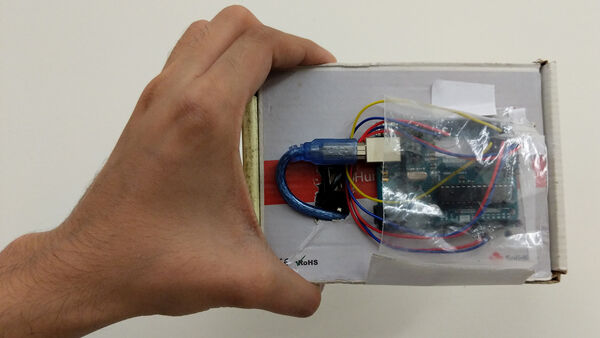
Using Wi-Fi Like Sonar to Measure Speed and Distance of Indoor Movement
"Researchers from North Carolina State University have developed a technique for measuring speed and distance in indoor environments, which could be used to improve navigation technologies for robots, drones – or pedestrians trying to find their way around an airport. The technique uses a novel combination of Wi-Fi signals and accelerometer technology to track devices in near-real time. “We call our approach Wi-Fi-assisted Inertial Odometry (WIO),” says Raghav Venkatnarayan, co-corresponding author of a paper on the work and a Ph.D. student at NC State. “WIO uses Wi-Fi as a velocity sensor to accurately track how far something has moved. Think of it as sonar, but using radio waves, rather than sound waves.” Many devices, such as smartphones, incorporate technology called inertial measurement units (IMUs) to calculate how far a device has moved. However, IMUs suffer from large drift errors, meaning that even minor inaccuracies can quickly become exaggerated." [...]

Researchers demonstrate three-dimensional quantum hall effect for the first time
"The three-dimensional quantum Hall effect was predicted more than 30 years ago, but has not been observed until now by the Singapore University of Technology and Design together with international researchers. The quantum Hall effect (QHE), which was previously known for two-dimensional (2D) systems, was predicted to be possible for three-dimensional (3D) systems by Bertrand Halperin in 1987, but the theory was not proven until recently by researchers from the Singapore University of Technology and Design (SUTD) and their research collaborators from around the globe. The Hall effect, a fundamental technique for material characterization, is formed when a magnetic field deflects the flow of electrons sideways and leads to a voltage drop across the transverse direction. In 1980, a surprising observation was made when measuring the Hall effect for a two-dimensional (2D) electron gas trapped in a semiconductor structure - the measured Hall resistivity showed a series of completely flat plateau, quantized to values with a remarkable accuracy of one part in 10 billion. This became known as the QHE. QHE has since revolutionized our fundamental understanding of condensed matter physics, generating a vast field of physics research." [...]

Synthesis of UV absorbers from cashew nut shell liquid
"A waste stream from food production is a valuable alternative for petroleum in the production of organic UV filters Researchers at Johannes Gutenberg University Mainz (JGU) in Germany, in collaboration with colleagues from the University of the Witwatersrand in Johannesburg in South Africa and the University of Dar-es-Salaam in Tanzania, succeeded in using cashew nut shell liquid (CNSL) as a substitute for petroleum in organic synthesis. Their aim was the development of a sustainable synthesis of soluble organic UV filters. The ultraviolet (UV) region of solar radiation is a potential health risk for humans and livestock. Extensive exposure may result in premature aging of the skin and even life-threatening forms of cancer. Moreover, the destructive power of natural UV radiation can also damage paints, coatings, and even plastics. One option to prevent radiation-induced damage is to employ chemical UV filters." [...]

Engineers demonstrate key step in robotic disassembly
"Engineers at the University of Birmingham have successfully designed a robotic system that can perform a key task in disassembling component parts. The research is an important advance for manufacturers looking for more efficient ways to build products from a combination of reused, repaired and new parts. Known as remanufacturing, this process is becoming increasingly commonplace in manufacturing and is attractive because it can use as little as 10 per cent of the energy and raw materials required to build the product from scratch. It can also reduce CO2 emissions by more than 80 per cent. A key part of the process is the ability to disassemble the ‘core’, the returned product. It’s a challenge because of the huge variety within these products, with lots of unknowns in the size, shape and condition of components." [...]
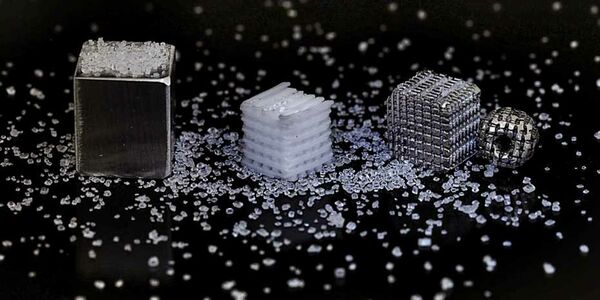
3D printed salt template for bioresorbable bone implants
"With the help of a 3D printed salt template, ETH researchers have succeeded in producing magnesium scaffolds with structured porosity that are suitable for bioresorbable bone implants. For the treatment of complex bone fractures or even missing bone parts, surgeons typically deploy metal implants. In this context, an attractive alternative to the traditional materials like bioinert titanium are biodegradable magnesium and its alloys. Implants made of the latter light metal are advantageous because they can biodegrade in the body, which can absorb magnesium as a mineral nutrient, rendering a second surgery for implant removal unnecessary. To promote rapid healing, the design of implants or their surfaces should be directed towards promotion of cellular adhesion or even in-growth. Materials researchers from the Laboratory of Metal Physics and Technology and the Complex Materials Group at ETH Zurich have therefore collaborated to develop a new procedure for the manufacture of magnesium implants that contain numerous structurally ordered pores but still retain their mechanical stability." [...]
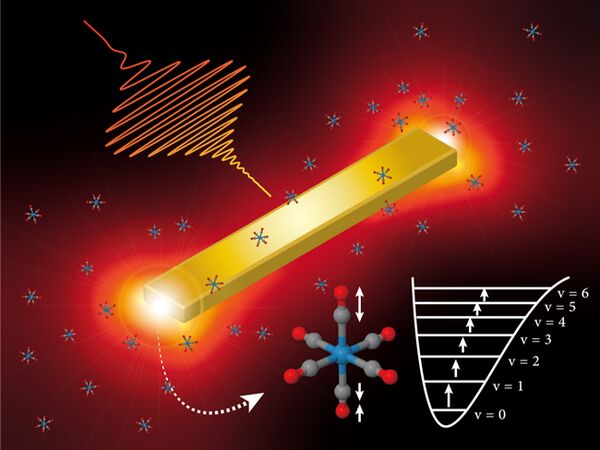
Better Chemistry Through Tiny Antennae
"A research team at The University of Tokyo has introduced a powerful method for actively breaking chemical bonds using excitations in tiny antennae created by infrared lasers. This process may have applications throughout chemistry as a way to direct chemical reactions in desired directions. In particular, the reactions used in the energy, pharmaceutical, and manufacturing sectors may become much more efficient by increasing yields while reducing waste. Chemistry is a messy undertaking, since there may be a variety of ways the starting chemicals can react, and each pathway might lead to the formation of a different product. Over the years, chemists have developed many tools--including changing the temperature, concentration, pH, or solvent--to nudge the reaction to maximize the yield of the desired molecules. However, if given the ability to selectively control the making or breaking of individual bonds within a molecule, scientists could greatly enhance the efficiency of these reactions, while minimizing unwanted side products." [...]
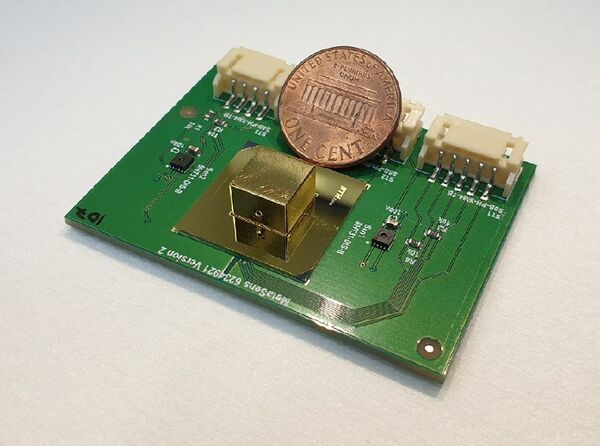
Researchers Demonstrate First All-Metamaterial Optical Gas Sensor
"Simple, low-power sensor is ideal for ‘Internet of Things’ and smart home devices Researchers have developed the first fully-integrated, non-dispersive infrared (NDIR) gas sensor enabled by specially engineered synthetic materials known as metamaterials. The sensor has no moving parts, requires little energy to operate and is among the smallest NDIR sensors ever created. The sensor is ideal for new Internet of Things and smart home devices designed to detect and respond to changes in the environment. It also could find use in future medical diagnostics and monitoring equipment. A paper explaining these results will be presented at the Frontiers in Optics + Laser Science (FIO + LS) conference, held 15–19 September in Washington, D.C., U.S.A. “Our sensor design unites simplicity, robustness, and efficiency. Using metamaterials, we can omit one of the main cost drivers in NDIR gas sensors, the dielectric filter, and simultaneously reduce the size and energy consumption of the device,” said Alexander Lochbaum from the Institute of Electromagnetic Fields of ETH Zurich, Switzerland, and lead author on the paper." [...]

Single atoms as catalysts
"Incorporating individual metal atoms into a surface in the right way allows their chemical behavior to be adapted. This makes new, better catalysts possible. They make our cars more environmentally friendly and they are indispensable for the chemical industry: catalysts make certain chemical reactions possible - such as the conversion of CO into CO2 in car exhaust gases - that would otherwise happen very slowly or not at all. Surface physicists at the TU Wien have now achieved an important breakthrough; metal atoms can be placed on a metal oxide surface so that they show exactly the desired chemical behavior. Promising results with iridium atoms have just been published in the renowned journal "Angewandte Chemie". Smaller and smaller – all the way down to the single atom For car exhaust gases, solid catalysts such as platinum are used." [...]
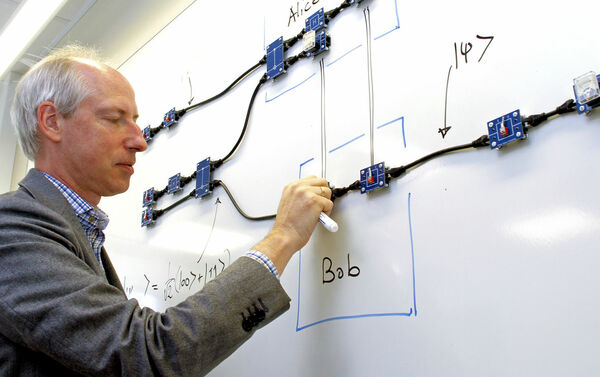
Spreading light over quantum computers
"Scientists at Linköping University have shown how a quantum computer really works and have managed to simulate quantum computer properties in a classical computer. “Our results should be highly significant in determining how to build quantum computers”, says Professor Jan-Åke Larsson. The dream of superfast and powerful quantum computers has again been brought into focus, and large resources have been invested in research in Sweden, Europe and the world. A Swedish quantum computer is to be built within ten years, and the EU has designated quantum technology one of its flagship projects. At the moment, few useful algorithms are available for quantum computers, but it is expected that the technology will be hugely significant in simulations of biological, chemical and physical systems that are far too complicated for even the most powerful computers currently available. A bit in a computer can take only the value one or zero, but a quantum bit can take all values in between." [...]

At the edge of chaos, powerful new electronics could be created
"Study shows how ferroic materials could be used to create adaptable neuromorphic electronics A phenomenon that is well known from chaos theory was observed in a material for the first time ever, by scientists from the University of Groningen, the Netherlands. A structural transition in the ferroelastic material barium titanate, caused by an increase or decrease in temperature, resembles the periodic doubling seen in non-linear dynamical systems. This ‘spatial chaos’ in a material was first predicted in 1985 and could be used in applications such as adaptable neuromorphic electronics. The results were published in Physical Review Letters on 22 August. A team of physicists at the University of Groningen, led by Professor of Functional Nanomaterials Beatriz Noheda, made their observation in thin films of barium titanate (BaTiO3), a ferroelastic material. Ferroic materials are characterized by their ordered structure, in shape (ferroelastic), charge (ferroelectric) or magnetic moment (ferromagnetic), for example." [...]
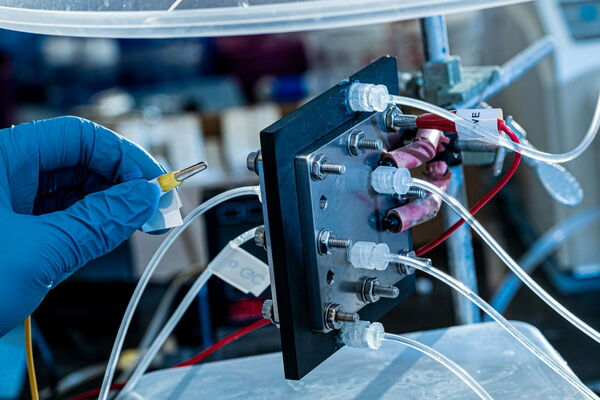
Rice reactor turns greenhouse gas into pure liquid fuel
"Lab’s ‘green’ invention reduces carbon dioxide into valuable fuels A common greenhouse gas could be repurposed in an efficient and environmentally friendly way with an electrolyzer that uses renewable electricity to produce pure liquid fuels. The catalytic reactor developed by the Rice University lab of chemical and biomolecular engineer Haotian Wang uses carbon dioxide as its feedstock and, in its latest prototype, produces highly purified and high concentrations of formic acid. Formic acid produced by traditional carbon dioxide devices needs costly and energy-intensive purification steps, Wang said. The direct production of pure formic acid solutions will help to promote commercial carbon dioxide conversion technologies. The method is detailed in Nature Energy. Wang, who joined Rice’s Brown School of Engineering in January, and his group pursue technologies that turn greenhouse gases into useful products." [...]

Entanglement sent over 50 km of optical fiber
"For the first time, a team led by Innsbruck physicist Ben Lanyon has sent a light particle entangled with matter over 50 km of optical fiber. This paves the way for the practical use of quantum networks and sets a milestone for a future quantum internet. The quantum internet promises absolutely tap-proof communication and powerful distributed sensor networks for new science and technology. However, because quantum information cannot be copied, it is not possible to send this information over a classical network. Quantum information must be transmitted by quantum particles, and special interfaces are required for this. The Innsbruck-based experimental physicist Ben Lanyon, who was awarded the Austrian START Prize in 2015 for his research, is researching these important intersections of a future quantum Internet." [...]
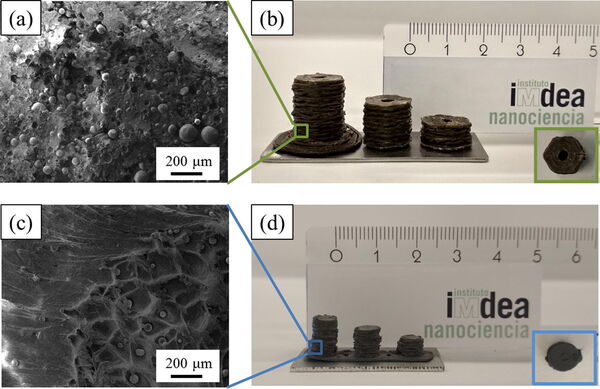
An industrial collaboration for thermally controlled 3D-printed metal/polymer components
"IMDEA Nanociencia’s research led by Dr. Palmero jointly with the company RAMEM has resulted in successful development of thermally controlled 3D-printed proof-of-concept metallic/polymer components. This work constitutes an industrial collaboration with applicability in the aeronautic and aerospace sectors. One of the main technological challenges when trying to combine metal particles with polymers for the fabrication of functional composites is the possibility of achieving a high metal concentration dispersed in a suitable polymer. Not every polymer is valid for the synthesis of metal-based composites since issues such as solubility are crucial. Challenges extend after the synthesis of the composite to the fabrication of a continuous wire or filament to achieve a high metal content and not just a polymeric product with dispersed metallic particles. This is of extreme importance to end with 3D-printed metal/polymer components providing high thermal conductivity (when needed) and mechanical stability in view of practical applications." [...]
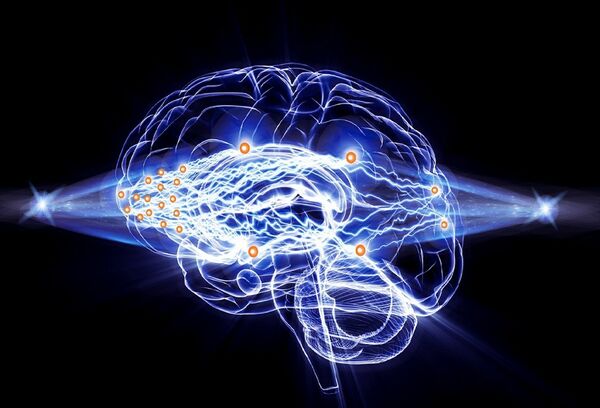
Researchers Demonstrate All-Optical Neural Network for Deep Learning
"New approach could enable parallel computation with light Even the most powerful computers are still no match for the human brain when it comes to pattern recognition, risk management, and other similarly complex tasks. Recent advances in optical neural networks, however, are closing that gap by simulating the way neurons respond in the human brain. In a key step toward making large-scale optical neural networks practical, researchers have demonstrated a first-of-its-kind multilayer all-optical artificial neural network. Generally, this type of artificial intelligence can tackle complex problems that are impossible with traditional computational approaches, but current designs require extensive computational resources that are both time-consuming and energy intensive. For this reason, there is great interest developing practical optical artificial neural networks, which are faster and consume less power than those based on traditional computers. In Optica, The Optical Society's journal for high-impact research, researchers from The Hong Kong University of Science and Technology, Hong Kong detail their two-layer all-optical neural network and successfully apply it to a complex classification task." [...]
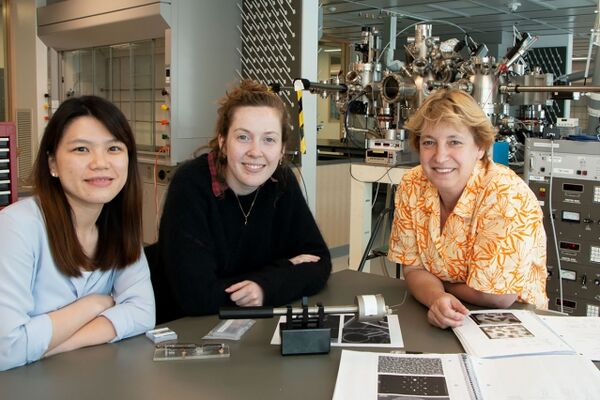
Creating new opportunities from nanoscale materials
"MIT Professor Frances Ross is pioneering new techniques to study materials growth and how structure relates to performance. A hundred years ago, “2d” meant a two-penny, or 1-inch, nail. Today, “2-D” encompasses a broad range of atomically thin flat materials, many with exotic properties not found in the bulk equivalents of the same materials, with graphene — the single-atom-thick form of carbon — perhaps the most prominent. While many researchers at MIT and elsewhere are exploring two-dimensional materials and their special properties, Frances M. Ross, the Ellen Swallow Richards Professor in Materials Science and Engineering, is interested in what happens when these 2-D materials and ordinary 3-D materials come together. “We’re interested in the interface between a 2-D material and a 3-D material because every 2-D material that you want to use in an application, such as an electronic device, still has to talk to the outside world, which is three-dimensional,” Ross says. “We’re at an interesting time because there are immense developments in instrumentation for electron microscopy, and there is great interest in materials with very precisely controlled structures and properties, and these two things cross in a fascinating way,” says Ross." [...]
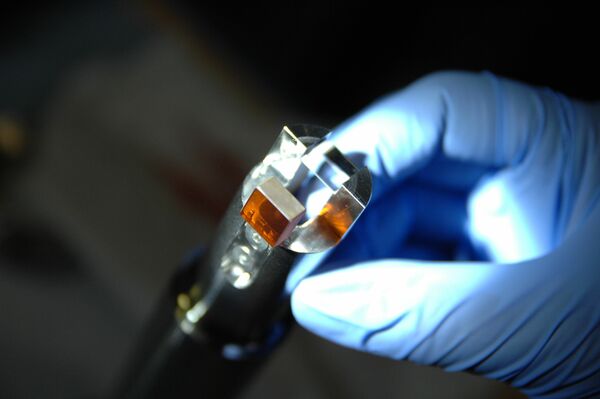
Developing Tomorrow’s Accelerator Technology
"BMBF Funds Accelerator Research at KIT with about EUR 3 Million under the Program “Erforschung von Universum und Materie – ErUM” Particle accelerators are key instruments for cutting-edge research in biology, medicine, materials science, and chemistry. They enable deep insight into the structure of matter. At the Accelerator Technology Platform (ATP) of Karlsruhe Institute of Technology (KIT), scientists from various disciplines work on the further development of accelerator technology. In a competition of all German universities, seven of their projects have now been selected for funding under the framework program “Erforschung von Universum und Materie – ErUM” (research into universe and matter) of the Federal Ministry of Education and Research (BMBF). The total funding volume amounts to about EUR 3 million. “At KIT, teams of experts from various disciplines cooperate to develop innovative technologies for tomorrow’s particle accelerators, from radiation diagnosis systems for highest data rates to special magnets based on high-temperature superconductors,” says KIT Vice-President for Research, Professor Oliver Kraft." [...]

Quantum computers and the future of computation
"Are there limits to what computers are actually able to compute, and do quantum computers really solve more problems than conventional computers? Computer scientist Scott Aaronson will discuss these kinds of fundamental questions during the Paul Bernays Lectures 2019. In 2007, an ad spot ran on Australian TV that involved two models in a dressing room discussing quantum mechanics. The two of them discuss how quantum mechanics is not physics in the usual sense; it’s not about matter, energy or waves, but about information, probabilities and observables. The notable thing about this advertisement is not that two models have a casual conversation about theoretical physics, but that quantum mechanics is represented not only as an interesting research perspective for physics, but also for computer science. This scientific position was not as widespread 12 years ago as it is today, now that quantum computing has developed rapidly and also established itself at ETH Zurich beyond physics." [...]

Atomically thin minerals show promise as proton conducting membranes for green technologies
"Researchers at The University of Manchester discovered that atomically- thin micas – the name given to a type of common mineral found in soil – are excellent proton conductors. This surprising result is important for the use of 2D materials in applications such as fuel cells and other hydrogen-related technologies. Previously, the Manchester researchers led by Professor Andre Geim and Dr Marcelo Lozada-Hidalgo found that one-atom thick materials like graphene are highly permeable to protons, nuclei of hydrogen atoms. However, they also found that other 2D materials such as molybdenum sulphide (MoS2), that were just three atoms thick, were completely impermeable to protons. These results suggested that only one-atom thick crystals could be permeable to protons. Writing in Nature Nanotechnology, the team have shown that protons can easily permeate through few-layered micas despite the fact that they are 10 times thicker than graphene." [...]
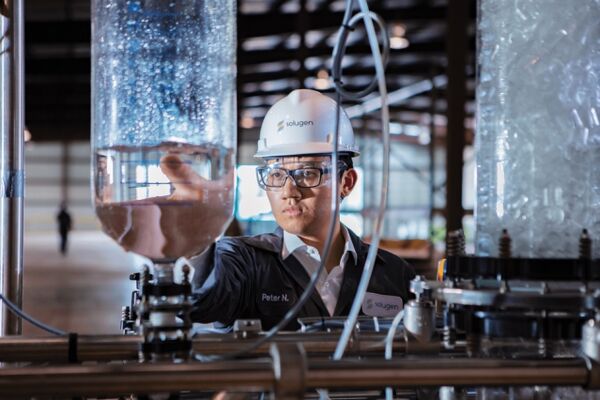
Cleaning up hydrogen peroxide production
"Solugen’s engineered enzymes offer a cheaper, safer, and far less toxic way to produce the chemical. The most common process for making hydrogen peroxide begins with a highly toxic, flammable working solution that is combined with hydrogen, filtered, combined with oxygen, mixed in water, and then concentrated to extremely high levels for shipping. The transportation process is equally convoluted. Most of the massive chemical plants that make hydrogen peroxide are located in Russia and China. For big markets like the U.S. oil and gas industry, concentrated hydrogen peroxide is usually freighted to America, diluted, then shipped via rail or truck to places like western Texas, where a service company buys it and pumps it for the customer. All of this complexity masks the fact that hydrogen peroxide is structurally simple." [...]
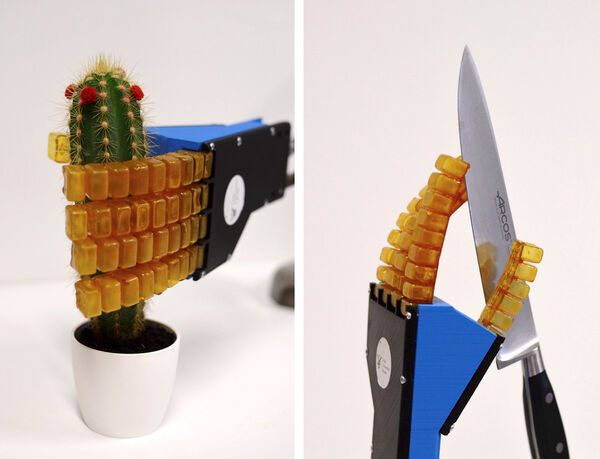
Soft Self-Healing Materials for Robots That Cannot Be Destroyed
"It'll take more than having its fingers chopped off to stop this robot hand If there’s one thing we know about robots, it’s that they break. They break, like, literally all the time. The software breaks. The hardware breaks. The bits that you think could never, ever, ever possibly break end up breaking just when you need them not to break the most, and then you have to try to explain what happened to your advisor who’s been standing there watching your robot fail and then stay up all night fixing the thing that seriously was not supposed to break. While most of this is just a fundamental characteristic of robots that can’t be helped, the European Commission is funding a project called SHERO (Self HEaling soft RObotics) to try and solve at least some of those physical robot breaking problems through the use of structural materials that can autonomously heal themselves over and over again." [...]

A key piece to understanding how quantum gravity affects low-energy physics
"Researchers have, for the first time, identified the conditions for theories of quantum gravity to be compatible with one of the paramount predictions of quantum theory and relativity: The Unruh effect. In a new study led by researchers from the University of Waterloo, the International School for Advanced Studies and the Complutense University of Madrid a, solid theoretical framework is provided to discuss modifications to predictions of quantum field theory caused by the microstructure of space-time. The Unruh effect, named after the Canadian physicist who theorized it in 1976, is the prediction that someone who has propulsion and hence accelerates would observe photons and other particles in a seemingly empty space while another person who is inertial would see a vacuum in that same area. “What we’ve done is analyzed the conditions to have Unruh effect and found that contrary to an extended belief in a big part of the community thermal response for particle detectors can happen without thermality,” said Eduardo Martin-Martinez, an assistant professor in Waterloo’s Department of Applied Mathematics. “Our findings are important because the Unruh effect is in the boundary between quantum field theory and general relativity, which is what we know, and quantum gravity, which we are yet to understand. “So, if someone wants to develop a theory of what’s going on beyond what we know of quantum field theory and relativity, they need to guarantee they satisfy the conditions we identify in their low energy limits.” The researchers analyzed the mathematical structure of the correlations of a quantum field in frameworks beyond standard quantum field theory." [...]
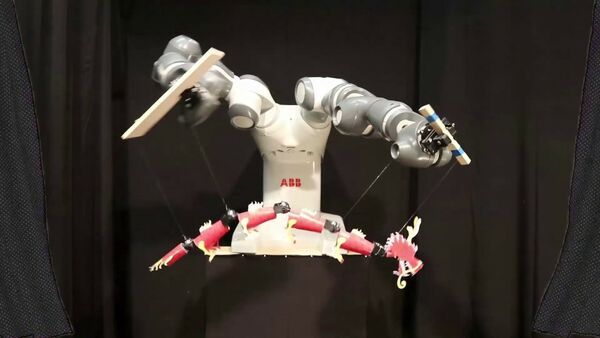
ETH Zurich Demonstrates PuppetMaster Robot
"Robots that can control puppets could one day learn to manipulate complex physical objects like clothing and flexible sheets As far as I know, the universe does not have a desperate need for robot puppeteers, and considering the difficulty of making even a halfway decent robot puppeteer, you’d think that any sensible roboticist would keep well clear of the problem. But some folks over at ETH Zurich decided that they’d have a crack at it anyway, and they started by describing why they’d likely be better off if they hadn’t: Marionettes are underactuated, high-dimensional, highly non-linear coupled pendulum systems. They are driven by gravity, the tension forces generated by a small number of cables, and the internal forces arising from mechanical articulation constraints. As such, the map between the actions of a puppeteer and the motions performed by the marionette is notoriously unintuitive, and mastering this unique art form takes unfaltering dedication and a great deal of practice. Our goal is to enable autonomous robots to animate marionettes with a level of skill that approaches that of human puppeteers. The ETH Zurich project can’t yet animate a complex marionette, but it’s a respectable showing with the dragon, I think." [...]
Tracking down polluters
"Proving criminal machinations can be difficult – for instance when those involved covertly discharge hazardous wastewater into sewers. A new sensor system developed by Fraunhofer researchers and their partners could soon help safety agencies establish wrongdoing: placed in a sewage canal, it detects relevant substances and helps isolate and expose polluters. There’s always one black sheep, and industry is no exception. While the majority of companies dispose of their wastewater properly, a few want to avoid the associated costs, so they quietly and surreptitiously discharge their hazardous wastewater into the sewage canals. By and large, safety agencies currently have no means of detecting this kind of environmental crime on a broad scale – doing so would far exceed their work-force capacity. But this illegal sewage poses major challenges for wastewater treatment facility operators and can even result in turnover of the affected wastewater treatment ponds." [...]
Projetos Maker
Diversos Projetos interessantes.
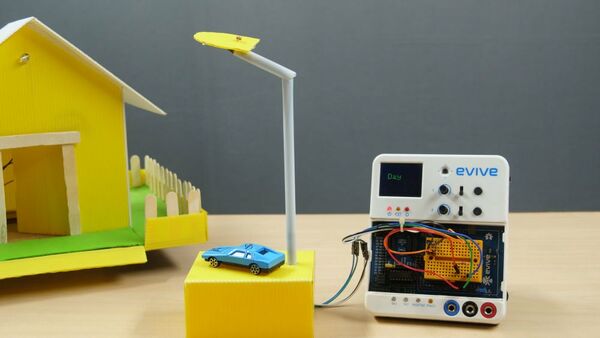
Automatic Street Light Using LDR or the Light Sensor
"It can never be overstated that learning by doing is the best way to learn. And we’re back again with a simple yet super fun to make DIY LED street light project for kids to make and learn a thing or two about LDR working and application and coding. We’ll be using components from the evive Starter Kit and some other DIY material to make the street light and write the code for it in PictoBlox - our Scratch based graphical programming software with advanced hardware interaction capabilities. You can download PictoBlox from HERE. Ready for some fun-filled learning by doing? Let’s begin!" [...]
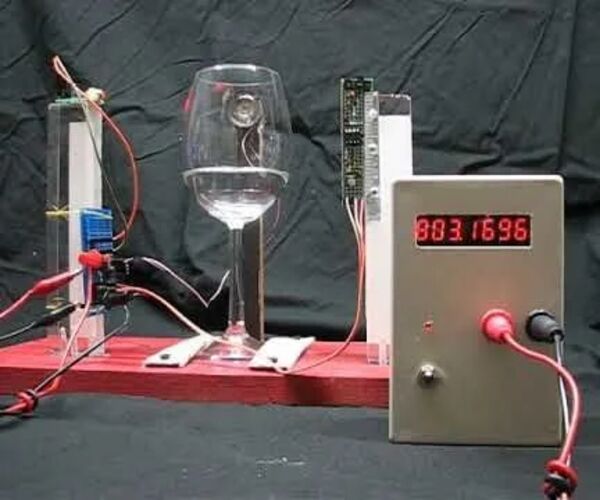
In Vino Veritas - a Wineglass Oscillator
"After I had finished a tuning fork oscillator, my brother challenged me to make an oscillator using a wineglass. ( https://www.instructables.com/id/Tuning-Fork-Osci... ) He thought it would be more difficult to use a wineglass than a tuning fork as the frequency determining element. It is. Everyone knows the sound a (wine) glass makes when you gently tap it, usually it sounds like a fast decaying "ping". Some, more expensive glasses can keep "singing" when you rub a wet finger over the edge. The sound this produces is caused by the glass quickly vibrating in a special way." [...]

Make Your Drone Gesture Controlled in $10
"This instructable is a guide to transforming your R/C Drone into a Gesture Controlled Drone in under $10! I am a person who is very much inspired by Sci-Fi movies and try to make the tech showed in the movie in real-life. This project is an inspiration from two such movies: "STAR WARS: The Empire Strikes Back" and "Project Almanac". In both the movies, you see a flying object (X-wing Starship & an R/C Drone) which were controlled by just hand movements. This inspired me to make something similar... Obviously I don't own the X-wing, so, unfortunately, I have to work with my Mini R/C Quadcopter. So the plan is - there will be an image processing script running on my laptop which will be continuously looking for my hand and track its position in the video frame." [...]
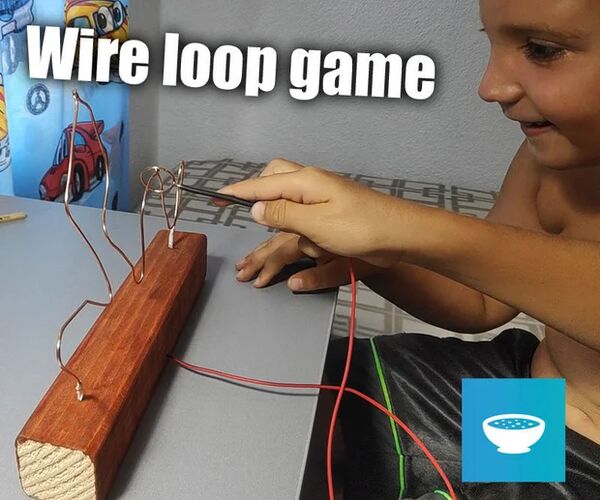
Wire Loop Buzzer Game
"In this Instructable, I will show you how I build a wire loop buzzer game for my kids. The wire loop game is made with an open circuit wire loop, that is connected to a buzzer. The wire has a ring around it and it is connected in such a way that if they touch, the buzzer will sound. Supplies: - 3-24V Piezo Electronic Buzzer Alarm 95DB - 60W/80W Electric soldering iron temperature adjustable - 100g 0.6/0.8/1/1.2 63/37 FLUX 2.0% 45FT Rosin Core Solder Soldering Wire Roll - Wirecutter pliers - 5pcs Forstner Wood Drill Bit Self Centering - 48VF 2-Speed Cordless Electric Screwdriver Impact Drill" [...]

Arduino LIXIE Clock
"Hey guys! I Hope you already enjoyed my previous instructable "Arduino MIDI Controller DIY" and you are ready for a new one, as usual I made this tutorial to guide you step by step while making this kind of super amazing low cost electronic projects which is the "Arduino LIXIE clock". During the making of this project, we tried to make sure that this instructable will be the best guide for you in order to help you if you want to make your own digital clock, so we hope that this instructable contain the needed documents. This project is so handy to make specially after getting the customized PCB that weve ordered from JLCPCB to improve the appearance of our clock and also there is enough documents and codes in this guide to allow you create your Arduino clock easily. We've made this project in just 4 days only, just three days to get all the needed parts and finish the hardware making and the assemble, then we have prepared the code to suit our project and the android app development takes one day. Before starting lets see first What you will learn from this instructable: Making the right hardware selection for your project depending on its functionalities." [...]
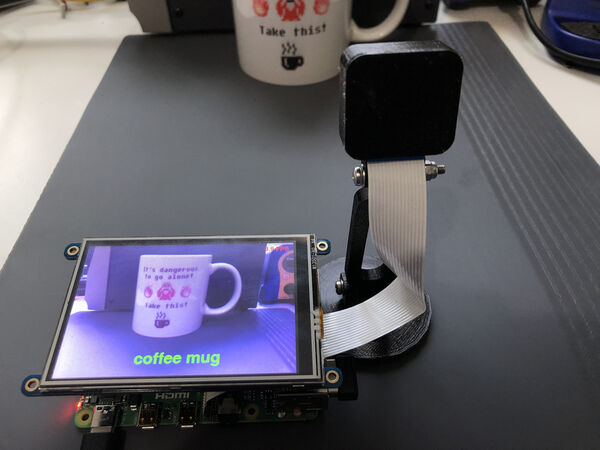
Running TensorFlow Lite Object Recognition on the Raspberry Pi 4
"Want to up your robotics game and give it the ability to detect objects? Maybe implement a security camera that can see and identify certain items? Now that the Raspberry Pi is fast enough to do machine learning, adding these features is fairly straightforward. In this guide we'll be showing you the steps you need to follow to get TensorFlow 2.0 and TensorFlow Lite running on your Raspberry Pi 4 and along with an object detection demo. " [...]
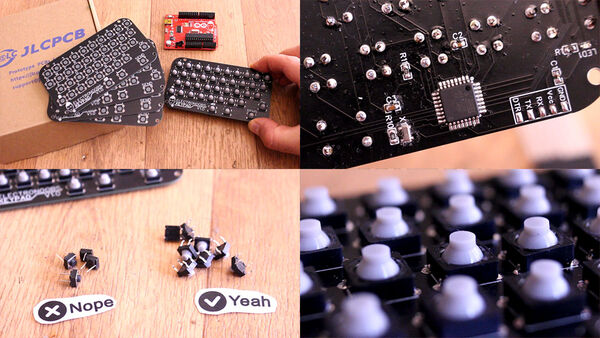
Arduino Keyboard Serial Output
"I've used "keypads" for Arduino in the past, but only numerical and with maybe 9 or 16 buttons, nothing more. In this tutorial I'll show you how I've made this PCB, how it works to detect all of the 40 buttons and how it will be the serial output. Once we have the keyboard we will be able to send to any microcontroller any character in lowcase, upercase, numbers and special characters such as question mark, exclamation, etc. I hope you will like this project and maybe it will be usefull for your projects where you need a full alphabet keybaord. " [...]

Set up Home Assistant with a Raspberry Pi
"Home Assistant is an open source operating system for a localized Smart Home Hub. Basically it works like IFTTT or Samsung Smart Things, but without having to send your data out onto the internet. This means that you have total control over your data, limit the amount of internet traffic from your smart devices, and tighten up security. Along with all of those things Home Assistant also allows you to create complex Scripts and Automations that blow other such Smart Home systems out of the water. Support for over 1400 devices means that just about every type of Smart Home device will likely work from consumer products like Hue, Lifx, Google Home, Alexa, Ecobee, Z-Wave, WeMo, IKEA Trådfri, and so many DIY devices that use things like Python or MQTT. Most IoT projects that use the ESP8266 or ESP32 can be tied into this system as easily as connecting to Adafruit.io." [...]
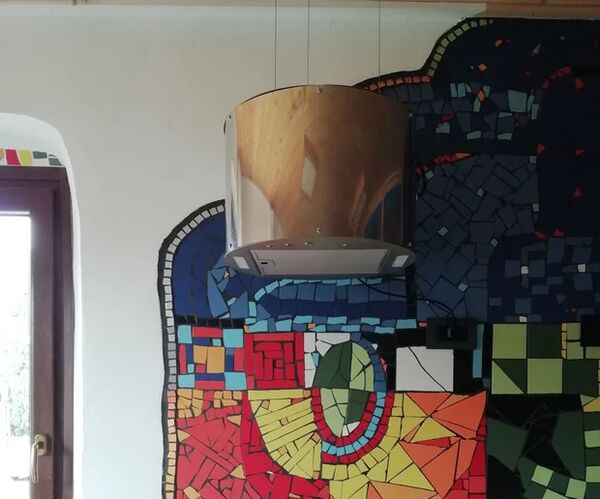
Stylish Steel Cooker Hood With Arduino
"Hello makers! I have a nice project with a lot of steel and quite some interesting electronics to show you today. This project sprouted from a concrete necessity that I had. I needed a kitchen hood but I wanted it to be hanging in a way that would hover over the cooker without ruining the mosaic tiles at the back of it. So I decided to build one, I wanted the kitchen hood to be durable so I decided to make it in stainless steel and I wanted it to be basic but technological so what else could I chose if not the great Arduino board to be the heart of it. I must admit that eventually the final product ended up quite more lavish than what I had expected." [...]

The SeparAItor
"The SeparAItor is a proof of concept of an autonomous recycling robot that exploits the power of deep learning to enhance human capabilities in a task that is both crucially important and severely underused (around 9% of plastic waste is recycled and 79% goes to landfills or to the environment). Since recycling is mainly a sorting exercise, and one of deep learning's main applications is the categorization of different images, this was a very natural progression. Keras (in TensorFlow2) is used for the machine learning part, mainly due to its simplicity, as well as some OpenCV for image preprocessing. Base The base consists of a simple pan and tilt system with a box on top. It comunicates with the computer over Bluetooth and is powered by an on-board battery, so the actuator part is completely independent. A Lazy Susan turntable bearing and a 608zz axial bearing provide mechanical stability to the system." [...]
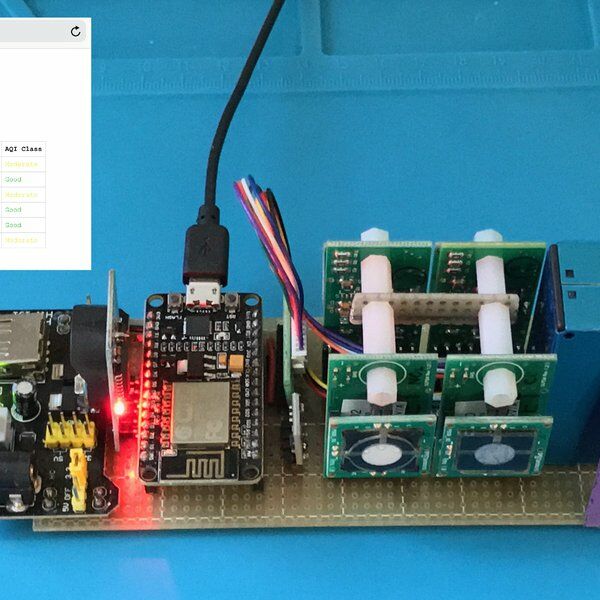
A More Complete Air Quality Monitor
"Samples all 6 metrics the EPA uses to calculate Air Quality Index: 2.5 & 10um particulates, O3, CO, NO2, and SO2, and calculates AQI. This prototype air monitoring system measures all six pollutants the EPA factors into its composite Air Quality Index (AQI). Most air monitor projects only measure particulate matter because fully-integrated particulate counters are cheap and easy to work with, with full onboard processing and a serial interface, and do not need to be recalibrated in the field. Ozone, carbon monoxide, and nitrous oxide are equally concerning, but until recently were not measurable without expensive lab equipment. This project uses factory-calibrated gas concentration sensors designed for medical equipment by Spec-Sensors. The gas sensors are sampled by a pair of 16-bit ADCs and heavily filtered on the ESP8266." [...]
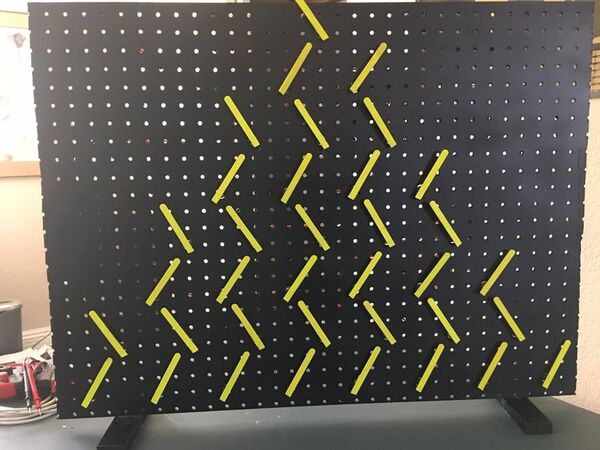
Servo Motor Artwork
"We use an Uno to control 36 servo motors and create digital animated artwork. The video below shows the action as 36 servo motors create an electronic work of art. An Arduino Uno and three 16-channel PWM servo controllers are working behind the scenes. The original inspiration for this was a much larger version with 450 servos I saw at a modern art museum. But even this small version with only 36 servos provides some interesting effects. There is an optional feature that I haven't shown in the video, but it can be added to make the display interactive." [...]

Voice-chess, a Chess Board With Voice Commands
"Hi! First of all, I wanna thank you just because you are my instructable. This is my first one and I want to share my knowledge and Ideas to the biggest number of people. I want to say also that English is not my mother tongue. Sorry for any mistake or bad grammar :D. So....lets move on! The Idea I am a chess player with many years of practice." [...]
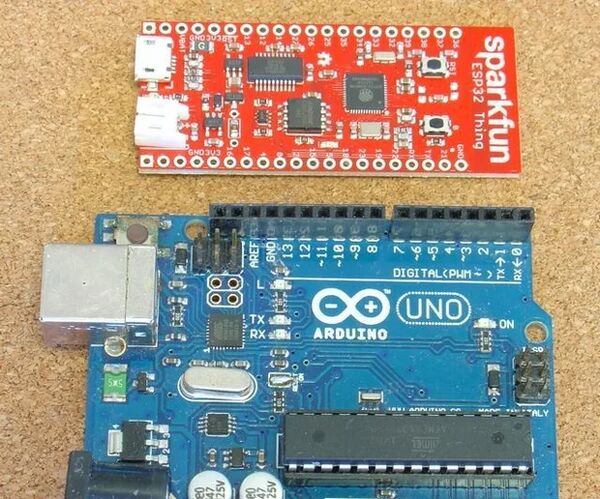
Simple Multi-tasking in Arduino on Any Board
"The instructable describes how to run multiple tasks on your Arduino without using an RTOS. Your 'tasks' are just normal methods, called directly from the loop() method. Each 'task' is given a chance to run each loop. You can either use a flag to skip 'tasks' that don't need to be run or, more often, just return immediately from the method call if that task has nothing to do. Each task is called in a round robin manner. As a practical application, this instructable will develop a temperature controlled, stepper motor driven damper with a user interface." [...]
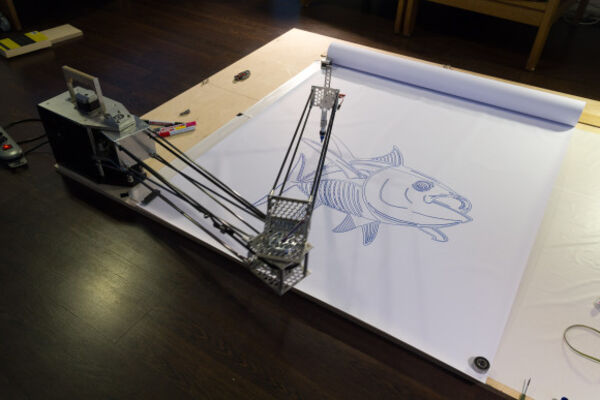
Mechpen
"This is Mechpen, my newest drawbot. The idea was to have a robot arm that could sketch on a rather large surface. It is a SCARA (Selective Compliance Assembly Robot Arm) robot arm, meaning the robot has a shoulder and an elbow joint and a hand. Mechpen has a reach of 140 cm which means it could sketch up to A0 format. Hardware Most self-built SCARA robots you find online are used for 3D-printing and have a rather limited range but good accuracy. Mechpen in contrast was designed to have a long range while still have ok-ish precision." [...]
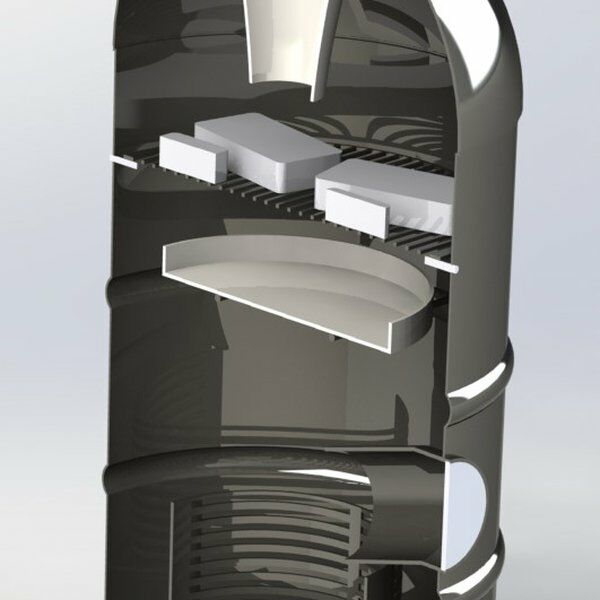
Smokey Mc Smokerson
"Automated barbecue and smoker on a budget Since summer is coming we decided that we needed a better way of smoking and bbq'ing. With the goal of perfecting this art on a budget, currently the Bill of Materials is estimated at around 200 euros. After going through several options such as using flower pots, this is the first iteration: oil barrel and Raspberry Pi based. Currently certain parts are still in the design stage and other are already on the way. " [...]
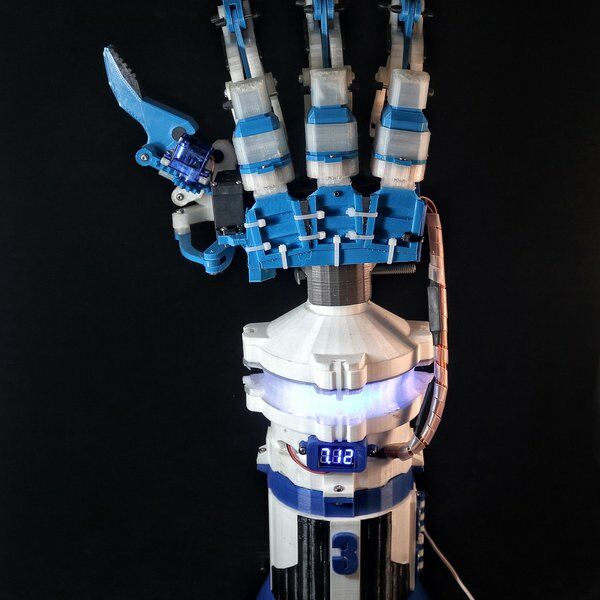
A Modular and Ambidextrous Humanoid Robotic hand
"A fully 3d printable, modular, ambidextrous, and powerful robot arm made from readily available and affordable components. My newest robot hand design! Each finger is it's own modular unit and the hand is incredibly easy to assemble/repair at a low cost. Each finger can be removed individually without disassembling the hand itself. This hand is meant to be as universal as possible. Fully customizable to fit its intended purpose, and ambidextrous - it can be either a right or a left hand depending on the configuration of the parts." [...]
That's all Folks!



